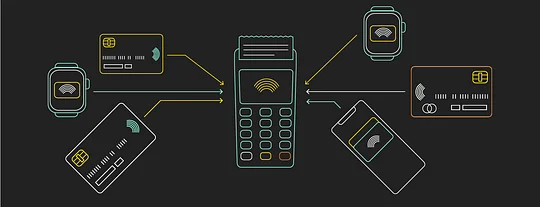Is the future really cashless?

Last year, we debated digital payments and whether they’re the future. At the time, it seemed like the answer was a resounding “yes". In the meantime, a global pandemic has emerged and transformed consumer behaviour in all areas of life — including the ways in which we pay.
But the question is, will this be a permanent change or will we revert to our pre-pandemic ways once it’s safe to do so? And if we do fast-forward to a completely cashless society, what will the implications be?
What’s changed recently?
The use of physical money was at an all-time low in the UK before the pandemic, with cash transactions representing only 23% of all payments in 2019, according to UK Finance. That was down from 28% in 2018, and 48% in 2014, demonstrating an ongoing move away from cash.
The coronavirus pandemic has only hastened this transition, as many people have stopped using cash amid fears physical money could transmit the virus. Those concerns are now thought to be unfounded, but it’s too little too late: customer behaviour has already changed, with 8% of adults using contactless cards for the first time during lockdown.
A Europe-wide increase in the maximum amount that can be made using a contactless transaction has further boosted digital payments. In the UK, you can now make contactless payments to the amount of £45, instead of £30.
Whether that behavioural change is permanent is yet to be seen, but it seems likely to stick. 14% of UK adults already say they no longer carry cash, and 16% say they would be happy to live in a cashless society.
Many businesses are also reluctant to return to accepting cash payments — 31% of Square's point of sale customers were operating on a cashless basis in July, compared to only 8% in January.
Those in the hospitality industry have been especially keen to embrace end-to-end digital transactions, with customers now regularly ordering and paying from their phones.
The dangers of going cashless
1. Financial exclusion
We can’t ignore the fact that a reduction in cash use disproportionately negatively impacts society’s most vulnerable segments — many of which overlap.
Older people
Older people are less likely to be familiar with using electronic payments and may feel uncomfortable trusting new technologies. If cashless payments become the norm, they might find themselves unable to access vital goods and services.
Many of the elderly also fall into another vulnerable group: those who cannot afford a smartphone and may also use cash as a way to budget due to very low incomes.
A proportion of the elderly population might also find making electronic payments more physically difficult than using cash. For example, visual impairments can make using small screens challenging, and mobility issues can hinder their ability to use mobile phones and pin pads.
Those in all three groups may also fall into a new coronavirus-related group: those with health conditions who can’t afford to take the risk of catching the illness.
Many in this segment are isolating and therefore reliant on others to carry out daily activities for them. Not being able to easily access cash makes this harder, because in most cases it results in handing over a card and PIN, which is not only dangerous for the already vulnerable, but it also breaches the T&Cs from their bank.
The pandemic has refuelled the closure of bank branches (the Post Office recently announced its plans to close a third of its cash machines) and a reduction in counter service hours in a bid to cut costs. This vicious circle negatively affects the vulnerable, as they might not be able to travel to their nearest cash access point.
Visual impairments can make using small screens challenging, and mobility issues can hinder the use of pin pads.
2. Technological difficulties
A reliance on cashless payments inevitably means a reliance on technology.
At its most basic level, this requires access to electricity, which can be an issue for stores that operate without permanent premises (like market traders).
A more common issue is a lack of quality connectivity. Who hasn't been in a restaurant and seen a member of staff wander into the garden with a card machine to get signal, or been told after they’ve eaten that the wifi has gone down and they need to pay with cash?
Cashless payments also require electronic hardware. Not everyone has a smartphone, meaning they’re automatically excluded from the QR-code and app-based payment systems that have become so popular recently. Homeless people in particular are unlikely to be able to accept cashless payments, which could make this period a very tough transition indeed.
On the business side, paying for a card terminal or phone dongle is an added cost, as are payment acceptance fees.
But does the good outweigh the bad?
Consumers
Many consumers have already gone cashless after being won over by the benefits:
- It’s more hygienic than physical cash, which is an ideal conductor for germs due to being constantly passed between strangers.
- Electronic payments are often faster. Tapping a phone, card or watch can be done with one hand or hands-free, allowing a spare hand to hold onto purchased items. Plus, there’s no longer a need to count out change.
- Some people may feel safer not carrying large quantities of cash around with them.
- Electronic payments can help consumers with budgeting, as card transaction records are consolidated and easily accessed via app or online. Many providers now offer in-app features such as instant payment notifications, so customers are immediately aware when money leaves their account.
- Cashless transactions reduce the need to come into close contact with another person - a major advantage during the coronavirus crisis.
Cashless transactions reduce the need for close contact - a major advantage during the coronavirus crisis.
Businesses
Businesses are increasingly seeing the benefits of not accepting cash:
- Faster transactions allow stores to serve more customers in less time.
- Cashless payments can also require fewer staff as transactions become more efficient, and staff no longer need to cash up or travel to a cash deposit point.
- Both employees and premises are less likely to be victims of crime, as employees no longer have to carry large sums to a deposit point, and cashless businesses that advertise this are less likely to be broken into.
- The risk of human error at point of sale is reduced and cash flow becomes easier to manage as all transactions are tracked.
- Stock and payment systems can be consolidated to provide holistic reporting of the business' position.
- Contactless payments protect staff from a hygiene point of view - being at the centre of an outbreak can damage a business irreparably, particularly if it's in the hospitality industry.
Where do we go from here?
Knowing what will happen tomorrow — let alone six months from now — is anyone’s guess! That said, there are a few outcomes which seem likely at this point.
A proportion of businesses that went cashless during the height of the pandemic will stay that way, especially as a second wave looms (although this will of course depend on industry and geography). And most consumers that have adopted new behaviours and a preference for contactless payments will likely continue with these where they’re able to do so.
An increase in the number of cashless businesses will prompt some governments and regulators to step in to encourage the continuation of cash acceptance. We’ve already seen this across the US, while the UK government is working with regulators to preserve access to cash to protect the vulnerable.
Recessions have now hit many countries, and historically, people have turned to cash during these times. Being able to physically hold their money offers comfort amid economic turmoil, particularly if banks fail like they did in 2007.
That said, cashless payments have increased dramatically since 2007, so we’re unlikely to see the same upsurge in cash use that we witnessed 13 years ago. Plus, banks have been subject to new regulatory regimes during that period, many of which have concentrated on maintaining sustainability in downturns.
Promisingly, though, recessions spark innovation. One area that saw huge activity following the 2008 crisis was, of course, fintech. It’s likely we’ll see the same happen this time, with a particular focus on products and services that help people better manage their money — whether that’s access to credit, help with budgeting or cashless payment alternatives for vulnerable groups.
The future of cash may be uncertain, but we can safely say that the future of fintech is far from bleak 💡



